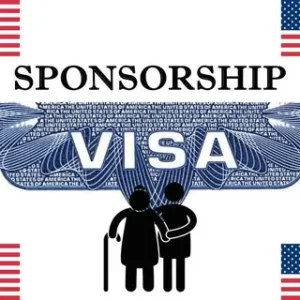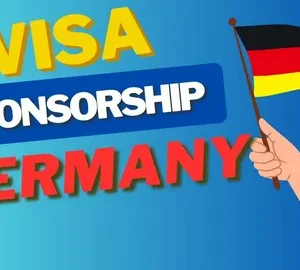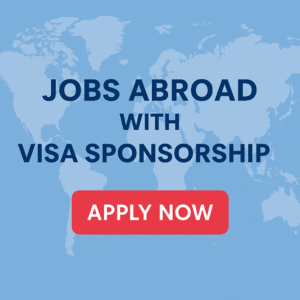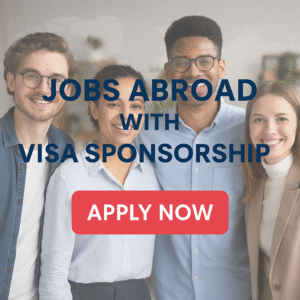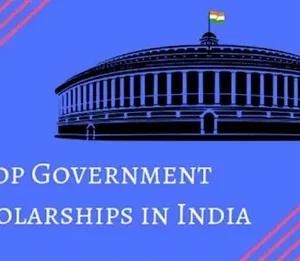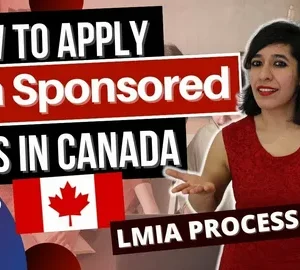There’s nothing quite like the thrill of getting a job offer from a U.S. employer that promises visa sponsorship. It’s not just a career move , it’s a life change.
In this post, I’ll walk you through everything you need to know about USA visa sponsorship jobs , what they are, how to find them, how to win them, and what your long-term path might look like. By the time you finish reading, you’ll feel confident to go after those opportunities head-on.
Here’s what we’ll cover:
-
What “visa sponsorship job” really means
-
Common U.S. work visas and eligibility criteria
-
Industries and roles that frequently offer sponsorship
-
Top companies known to sponsor visas
-
How to find real listings (with links)
-
Smart strategies to make your application irresistible
-
The visa application & employer process explained
-
Common challenges and how to overcome them
-
From visa to green card: your long-term path
-
FAQs you’ll want answers to
—
1. What Does “Visa Sponsorship Job” Mean?
Let’s start with the basics.
A visa sponsorship job is a position where a U.S. employer agrees to help you get legal permission (a visa) to live and work in the U.S. In effect, the employer becomes your “sponsor” by filing required paperwork and fulfilling legal obligations on your behalf.
Why is that important? Because for most foreign nationals, you can’t just show up and start working in the U.S. legally without proper documentation, you need authorization. And in many cases, that authorization must come through your employer.
So, when you see “visa sponsorship available,” it means:
-
The employer is (or is willing to be) compliant with U.S. immigration laws
-
They are ready to take on the administrative, legal, and financial burden to bring you in
That’s a big advantage. But note: not all jobs allow this. Many employers prefer candidates who already hold a U.S. work permit, so seeing a role with sponsorship jobs is a sign the company is open-minded and forward-thinking.
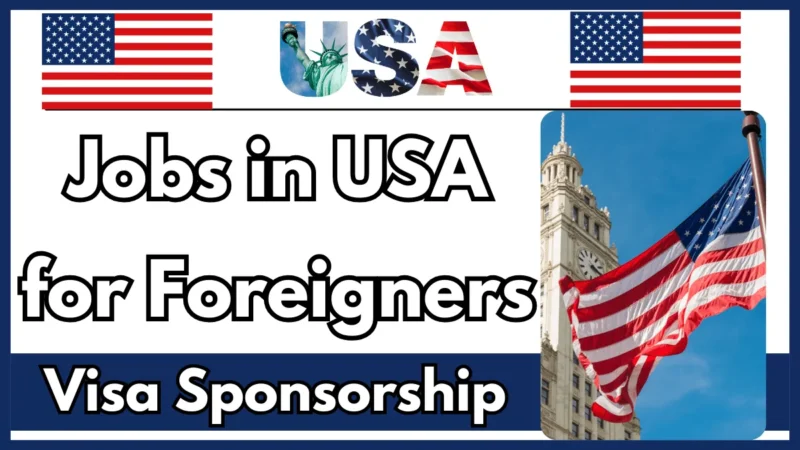
2. Common U.S. Work Visas & Eligibility Criteria
(Yes, you need to know this. Your understanding of visa types will make your sponsorship jobs hunt smarter.)
H-1B: Specialty Occupation Visa
One of the most famous work visas. It’s for jobs requiring specialized knowledge (think engineers, software developers, architects, data scientists).
-
Requires at least a bachelor’s degree (or equivalent) in a related field.
-
Employer must file Labor Condition Application (LCA) with U.S. Department of Labor.
-
Typically issued for 3 years, renewable for up to 6 years (or more under certain conditions).
-
Subject to an annual cap (65,000 plus 20,000 more for U.S. master’s degree holders).
-
The employer is responsible for fees, paperwork, etc.
-
More info: see Wikipedia’s H-1B visa page Wikipedia
EB-2 / EB-3 (Green Card via Employment)
These are immigrant visa categories (for permanent residence). If an employer is willing to sponsor an EB-2 or EB-3, that means they will help you become a permanent resident.
-
EB-2: Advanced degrees or individuals of exceptional ability.
-
EB-3: Professional (bachelor’s degree) or skilled workers (with 2+ years training).
-
Requires PERM labor certification to prove no qualified U.S. workers are available.
-
Employer must file Form I-140 (Immigrant Petition for Alien Worker) on your behalf.
Other Visas
-
J-1 / J-2: Exchange visitor visas. (J-2 holders can apply for work authorization with an EAD).
-
L-1: For employees of multinational companies transferring within the same company.
-
O-1, TN, H-2B, etc., depending on your field and location.
Understanding which visa matches your skills is key, you don’t want to waste time chasing roles you’re ineligible for.
Check this also: Get hired in Canada now
3. Industries & Roles That Commonly Offer Sponsorship jobs
Certain sectors are more likely to sponsor employees. If you’re new to this, think of “visa sponsorship jobs friendly” as a filter you can layer on top of your dream job search.
Here are industries and roles where visa sponsorship jobs are more common:
-
Tech & IT: Software engineers, devops, data analysts, AI/ML engineers
-
Healthcare: Nurses, physical therapists, physicians, medical technicians
-
Finance & Accounting: Quantitative analysts, financial modeling, risk analysts
-
Engineering: Mechanical, civil, electrical, chemical, aerospace
-
Consulting & Business Services: Firms that work globally
-
Research & Academia: Professors, postdocs, researchers
-
Hospitality & Tourism: Less common, but some large hotel chains sponsor seasonal workers
Why these fields? They often require specialized skills that local labor markets cannot always fill, which gives employers justification to sponsor.
Now, does that mean non-tech people don’t have a chance? Not at all. It just means you’ll need to find those niche sponsors who are willing to go the extra mile.
—
4. Top U.S. Companies Known to Sponsor Visas
If you want to target your job search, these are the names that come up again and again in visa sponsorship ranks.
-
Amazon, Microsoft, Google, Apple, Meta; these are big tech giants regularly found in H-1B sponsorship lists. The Times of India
-
Nvidia has publicly reaffirmed its commitment to sponsoring H-1B visas. Reuters
-
Consulting firms (Accenture, Deloitte, etc.) also sponsor.
-
Universities and research institutions often sponsor for faculty, research staff.
To dig deeper, check MyVisaJobs employers database, where you can see which companies have sponsored visas historically and in which roles. myvisajobs.com+1
If you apply to these, you boost your odds, because they already know how to handle the paperwork and process.
—
5. How to Find Real USA Visa Sponsorship Jobs Listings
You’ve got skills. Now you need real opportunities. Here’s where to look:
Job boards with visa-friendly roles
-
MyVisaJobs — curated U.S. jobs with visa-support options. myvisajobs.com
-
VisaSponsor.jobs — global visa sponsorship jobs listings (filter U.S.). visasponsor.jobs+2visasponsor.jobs+2
-
USponsorme.com — U.S. sponsorship jobs open to foreigners. USponsor Me
-
H1BVisaJobs.com — roles that historically support H-1B visas. h1bvisajobs.com
Mainstream sites with filters
-
Indeed — search “visa sponsorship jobs” or “visa sponsorship available.” Indeed+2Indeed+2
-
LinkedIn — many listings labeled “visa sponsorship jobs.” LinkedIn+1
-
Glassdoor — you can sometimes filter for “visa sponsorship jobs” roles. Glassdoor
-
ZipRecruiter — search “Visa Sponsorship Available.” ZipRecruiter
Pro tip: Search smart
Use search strings like:
-
“H-1B visa sponsorship jobs”
-
“Green card sponsorship employment”
-
“Visa sponsor company hiring now”
And always look for roles already offering sponsorship jobs, don’t rely on roles that don’t mention it (unless you’re comfortable asking later).
Below are some live examples (as of when I checked):
-
Indeed shows 5,000+ jobs with visa sponsorship. Indeed
-
Glassdoor lists over 10,000 U.S. visa sponsorship jobs. Glassdoor
-
VisaSponsor.jobs has listings specific to U.S. job titles. visasponsor.jobs+1
—
6. Smart Strategies to Make Your Application Irresistible
Okay, we have the listings. But you still have to beat out dozens (if not hundreds) of candidates. Here’s how to get noticed:
✅ Tailor your resume and cover letter
-
Mention in your summary that you require visa sponsorship (if you’re comfortable doing so).
-
Use keywords from the job description (match skills and terms).
-
Show your impact: numbers, metrics, outcomes.
-
Include a short line like, “Authorized to work in U.S. with visa sponsorship support if required.”
✅ Build a visa-aware portfolio
-
If you’re a developer, have a GitHub/portfolio.
-
For design, research, content, your own site or detailed samples matter.
-
Make it easy for employers to assess you without needing further clarification.
✅ Highlight cross-border or remote experience
If you’ve worked with remote U.S. teams or clients internationally, shout that out. It helps ease their concerns that you can adapt to U.S. work culture.
✅ Network like crazy
-
Connect with employees in target companies on LinkedIn.
-
Join communities like “International Employees in XYZ Company” or visa support groups.
-
Attend webinars or meetups where U.S. recruiters are present.
✅ Be proactive about visa questions
By the time you get to the interview stage, be prepared to talk about:
-
What visa you need
-
The timeline involved
-
Any constraints on start date, travel, or status change
If you’ve already done your homework, this won’t scare them, it’ll signal you’re serious and prepared.
—
7. The Visa & Employer Process: What Happens After an Offer
Landing the offer is one thing — now comes the real journey with paperwork, timelines, and patience.
Step 1: Employer files Labor Condition Application (LCA)
For many work visas (e.g. H-1B), your employer must file an LCA with the Department of Labor, showing that your employment won’t negatively impact U.S. workers.
Step 2: Employer files the petition (e.g. I-129 for H-1B, or I-140 for green card)
They submit supporting documents on your behalf. This includes contracts, educational proofs, proof of company finances, etc.
Step 3: USCIS adjudication
USCIS reviews. This process can take months (or more). Premium processing may be available.
Step 4: Consular processing or adjustment of status
If you’re outside the U.S., you’d get visa stamp at a U.S. consulate. If you’re inside legally, you might adjust status.
Step 5: Visa is issued, you travel (if abroad)
Once approved, you can enter the U.S. on that visa and begin work (per rules).
Step 6: Extensions, renewals, or green card process
You may apply for renewals. If employer is supportive, they might sponsor you further for permanent residency.
Don’t skip this: timelines matter. Sometimes job start dates can’t be immediate because of visa processing delays. Be upfront.
8. Common Challenges & How to Overcome Them
Yes, there are roadblocks. But don’t lose hope, people get through them all the time.
Challenge: Visa caps / lottery
For example, H-1B visas are often oversubscribed and allocated by lottery.
Workaround: Target cap-exempt employers (like universities, nonprofits), or other visa types (L-1, O-1).
Challenge: Employer reluctance
Some employers avoid sponsoring due to cost and administrative burden.
Solution: Emphasize you understand the process, offer to help with paperwork, or target companies historically sponsoring visas.
Challenge: Timing & delays
Processing may take months, delaying your start.
Solution: Be flexible in timelines; indicate willingness to wait or begin remotely.
Challenge: Job role mismatch
Some roles may not meet the “specialty occupation” requirement.
Solution: Ensure your role is strongly aligned with your degree or specialty. If you’re shifting fields, get more domain-specific experience or certifications.
Challenge: Changing immigration policies
Laws and fees can change (e.g. new fees for H-1B). Stay updated.
Example: Nvidia reaffirmed its sponsorship commitment despite new policy changes. Reuters
—
9. From Visa to Green Card: Long-Term Pathways
Getting a visa is awesome, but many people want permanent status eventually. Here’s how you can plan ahead.
Pathway: Employer-sponsored green card
-
Many start with H-1B, then employer files PERM and I-140 for EB-2 or EB-3.
-
If successful, you can file for Adjustment of Status (I-485).
-
This route takes years in many cases, especially for certain nationalities with long backlogs.
Self-petition options
-
National Interest Waiver (NIW): If you can argue your work is in national interest, you might skip needing employer support. (Used with EB-2)
-
Extraordinary ability (EB-1): If you’re very advanced in your field, you may not need a job offer in some cases.
Other options
-
Marriage to U.S. citizen (if applicable)
-
Diversity visa lottery (if eligible)
Your first job may often be a stepping stone. Choose employers who are open to sponsoring your green card later.
—
10. Sample Job Application Links (with sponsorship jobs)
Here are some live job boards (as of latest check) that often contain visa-sponsorship roles:
Click through those links, filter for your skill set, and look specifically for roles that mention “visa sponsorship” or “H-1B,” “Green Card support,” etc.
11. Step-by-Step Plan: Your Game Plan to Getting a Visa Sponsorship Jobs
Here’s a practical checklist you can follow:
-
Clarify your visa eligibility — Which visa(s) can you apply for? H-1B? EB-3?
-
Build your “visa-friendly” resume & portfolio — Include specifics, outcomes, metrics.
-
Target companies with history of sponsorship jobs— Use MyVisaJobs, H1B database.
-
Search job boards with the right keywords — “visa sponsorship jobs,” “H-1B,” “Green Card support.”
-
Tailor your cover letters & outreach — Show you’ve researched the visa process.
-
Network in niche communities — LinkedIn diaspora groups, forums, alumni connections.
-
Prepare for visa-related interview questions — Know timelines, limitations.
-
Upon offer, ask for a written sponsorship agreement — to protect your interests.
-
Stay in touch and be responsive during the visa process — you’ll need to provide docs.
-
Plan your next steps (green card, extension, etc.) early
If you follow this path and stay consistent, you tilt the odds in your favor.
12. Real-Life Success Stories & Tips
I won’t bore you with too many, but here are a few illustrative insights from real candidates:
-
Someone once said: “I used this platform called VisaBridge to help me find a visa sponsorship jobs. It took five months to get an offer, but worth it.” Reddit
-
Many international students use OPT (Optional Practical Training) to join a U.S. company, then the employer transitions them to H-1B.
-
Some people accept lower-paying roles initially just to get the sponsorship and then move up once they’re in.
The lesson? Patience, persistence, and strategic positioning often matter more than sheer skill.
—
13. Legal & Ethical Considerations (Don’t Skip This)
-
Employers must obey labor laws; they can’t underpay you just because you’re foreign.
-
You should always sign a contract stating the terms.
-
Be wary of scam job postings promising “guaranteed visa.” Legit sponsors will have verifiable history.
—
14. How to Negotiate Your Offer (Even as a Visa Candidate)
Yes, you can negotiate even when visa is involved.
-
Ask that the employer cover all visa fees (USCIS, lawyer, etc.).
-
Request that any relocation costs be included.
-
Negotiate for a later start date if visa processing will take time.
-
Ask for a commitment or guarantee that they’ll support your green card (if that’s your goal).
Your leverage: You bring skills they might struggle to find locally.
15. Do’s & Don’ts: Final Tips Before You Apply
Do:
-
Be transparent early about visa needs.
-
Overdeliver in your interviews.
-
Use data / metrics in your resume.
-
Aim for companies with prior sponsorship jobs experience.
-
Follow up politely after applying.
Don’t:
-
Hide your visa needs until last minute
-
Apply to every job (quality > quantity)
-
Ignore the legal side of things
-
Get discouraged by rejections (they’re part of the process)
-
Lose momentum stay consistent
Conclusion
Landing visa sponsorship jobs in the U.S. isn’t easy, there’s paperwork, competition, and uncertainty. But it’s far from impossible. If you combine your technical or domain skills with a smart strategy, solid resume, targeted search, and persistence, you improve your chances dramatically.
Remember: you’re not just applying for a job; you’re applying for a life opportunity. Respect the process. Be patient. Stay resilient. And keep pushing forward for your sponsorship Jobs.
FAQs
Q1: Do most U.S. companies sponsor foreign workers?
A: No. Many prefer candidates who already have authorization. That’s why seeing “visa sponsorship available” is a powerful signal — it means you’re in the minority, but those roles can be gold mines. Focus on companies known for international hiring (tech firms, universities, consultancies) and use specialized job boards like MyVisaJobs or VisaSponsor.jobs.
Q2: Is it better to first come to the U.S. on a student visa and then transition to employment?
A: Many people do exactly that — they study (F-1 visa), use OPT (Optional Practical Training), then leverage that experience to find an employer who sponsors H-1B or green card. But it depends on your field and plan. The route can ease the transition, but it’s not guaranteed.
Q3: How long does it take from job offer to visa approval?
A: It varies. For an H-1B, from filing to approval might take anywhere from 3 months to 9+ months (especially if there’s a backlog or premium processing delays). For green card processes (PERM + I-140 + adjustment), it can take years. Always build time buffers into your planning.
Q4: Can I switch employers after securing visa sponsorship jobs?
A: Yes, but with caveats. For many visa types (like H-1B), you can change employers if the new employer files a transfer petition. But you must stay compliant, and there could be restrictions. Always consult an immigration attorney before switching mid-process.
Q5: What if a job doesn’t explicitly say “visa sponsorship jobs”? Should I still apply?
A: You can, but with caution. Some companies are open but don’t advertise it. If your skills are exceptional, they might consider sponsoring. But be prepared for rejections or questions. A safer bet is targeting roles that already state sponsorship jobs to avoid wasted effort.
